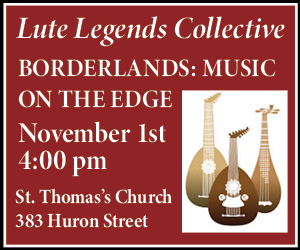Up to 1948 when Columbia Records introduced Long Playing discs, 78rpm recordings were the medium for home use. These discs had a limited frequency response but in 1945 British Decca astounded the industry and the record buying public around the world with their Full Frequency Range Recordings. Thus was born the Decca Sound and the logo FFRR on the label guaranteed state-of-the-art fidelity. The FFRR technology was even better realized on their new long playing discs which sonically eclipsed the Columbia product. Later FFRR became FFSS for Full Frequency Stereo Sound. Today, as always, Decca on the label is an assurance of excellent sound.
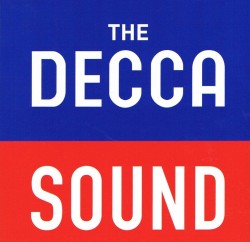 THE DECCA SOUND (DECCA 4782866) is a Limited-Edition, 50-CD set of outstanding performances and recordings dating from 1957 until 2009 packaged in a cube taking only five and a quarter inches of shelf space. As to be expected, there are many familiar works and a wealth of off the beaten track items. A very important factor in this particular collection is the roster of artists, many exclusive to Decca, heard at their distinguished best in their chosen repertoire. Even though there are no subsequent re-mastering dates revealed, in no cases did any performance sound less than freshly minted with spacious, translucent sound clarifying textures from top to bottom. The complete list of contents may be seen on the Decca web site www.deccaclassics.com. Each of the 50 CDs is sleeved in a fine board facsimile of the original CD cover. The 198 page booklet gives complete details of recording dates, venues, producers, etc., together with an extensive history of Decca from 1937 when Edward Lewis assembled a hand-picked collection of experienced sound engineers including the inspired and inspiring, forward-looking Arthur Haddy who headed the Decca team for decades. Given the excellence of the contents and presentation, at about $2.50 per disc this package is just about irresistible.
THE DECCA SOUND (DECCA 4782866) is a Limited-Edition, 50-CD set of outstanding performances and recordings dating from 1957 until 2009 packaged in a cube taking only five and a quarter inches of shelf space. As to be expected, there are many familiar works and a wealth of off the beaten track items. A very important factor in this particular collection is the roster of artists, many exclusive to Decca, heard at their distinguished best in their chosen repertoire. Even though there are no subsequent re-mastering dates revealed, in no cases did any performance sound less than freshly minted with spacious, translucent sound clarifying textures from top to bottom. The complete list of contents may be seen on the Decca web site www.deccaclassics.com. Each of the 50 CDs is sleeved in a fine board facsimile of the original CD cover. The 198 page booklet gives complete details of recording dates, venues, producers, etc., together with an extensive history of Decca from 1937 when Edward Lewis assembled a hand-picked collection of experienced sound engineers including the inspired and inspiring, forward-looking Arthur Haddy who headed the Decca team for decades. Given the excellence of the contents and presentation, at about $2.50 per disc this package is just about irresistible.
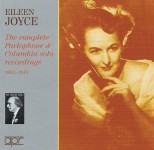
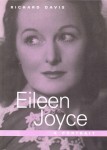 EILEEN JOYCE: The complete Parlophone & Columbia solo recordings 1933-1945 (Appian Publications & Recordings APR 7502, 5 CDs). Today, only collectors and archivists recognize her name, but in the 1930s, 40s and 50s Eileen Joyce was a pianist held in high esteem by her fellow musicians, critics and record collectors. She was born in Tasmania in 1908 and grew up in Boulder City, Western Australia. Her talent was recognized at an early age. Later Percy Grainger described her as “the most transcendentally gifted child he had ever heard.” She studied in Leipzig from 1927 until she moved to London early in 1930 where she was accepted by Tobias Matthay, one of the great musical pedagogues of his time, whose methods had produced many successful pianists including Myra Hess and Clifford Curzon. Her career took off in 1933 and she was in demand both as a recitalist and in concertos, appearing with such conductors as Beecham, van Beinum, Karajan, de Sabata, Celibidache, Ormandy, Wood, Szell and the rest. In those days it was still accepted and indeed expected that performing artists would have their own signature style and sound. Therefore there was more variation between them, as to how they produced their sounds and how they projected it in the music. The collectors of historic recordings are fascinated by this individuality which has become rare in the last half century. Eileen Joyce’s style can be characterized as bold, assured, and confident, and from these recordings could be classified as being on the dry or percussive side, although that may be attributable to the recording. She demonstrates, however, that she delivers a singing quality when she selects to do so. As a result, her communication to the listener is not always as immediate as we find in some of her contemporaries. Bryce Morrison states in the informative liner notes that “Virtually all of her recordings in this issue have the power to reinvent themselves so that you seem to be forever hearing them for the first time.” Joyce’s public most wanted to hear her play Schubert, Liszt, Chopin, Debussy and Grieg but, as we hear here, she played Bach, Beethoven, Schumann, Rachmaninov, Shostakovich – the list goes on – together with such fashionable salon pieces as The Rustle of Spring, Melody in F, Lotus Land, Widmung, etc. Also included in the 94 tracks is Mozart’s Concert Rondo K386 with orchestra. Although the repertoire is attractive, this set is primarily aimed at the specialist collector of historic pianists. For those who may be interested in Eileen Joyce and her times, there is a fascinating and revealing 264 page biography written by Richard Davis and published by the Freemantle Arts Centre Press titled, Eileen Joyce: A Portrait (ISBN 186368333-X).
EILEEN JOYCE: The complete Parlophone & Columbia solo recordings 1933-1945 (Appian Publications & Recordings APR 7502, 5 CDs). Today, only collectors and archivists recognize her name, but in the 1930s, 40s and 50s Eileen Joyce was a pianist held in high esteem by her fellow musicians, critics and record collectors. She was born in Tasmania in 1908 and grew up in Boulder City, Western Australia. Her talent was recognized at an early age. Later Percy Grainger described her as “the most transcendentally gifted child he had ever heard.” She studied in Leipzig from 1927 until she moved to London early in 1930 where she was accepted by Tobias Matthay, one of the great musical pedagogues of his time, whose methods had produced many successful pianists including Myra Hess and Clifford Curzon. Her career took off in 1933 and she was in demand both as a recitalist and in concertos, appearing with such conductors as Beecham, van Beinum, Karajan, de Sabata, Celibidache, Ormandy, Wood, Szell and the rest. In those days it was still accepted and indeed expected that performing artists would have their own signature style and sound. Therefore there was more variation between them, as to how they produced their sounds and how they projected it in the music. The collectors of historic recordings are fascinated by this individuality which has become rare in the last half century. Eileen Joyce’s style can be characterized as bold, assured, and confident, and from these recordings could be classified as being on the dry or percussive side, although that may be attributable to the recording. She demonstrates, however, that she delivers a singing quality when she selects to do so. As a result, her communication to the listener is not always as immediate as we find in some of her contemporaries. Bryce Morrison states in the informative liner notes that “Virtually all of her recordings in this issue have the power to reinvent themselves so that you seem to be forever hearing them for the first time.” Joyce’s public most wanted to hear her play Schubert, Liszt, Chopin, Debussy and Grieg but, as we hear here, she played Bach, Beethoven, Schumann, Rachmaninov, Shostakovich – the list goes on – together with such fashionable salon pieces as The Rustle of Spring, Melody in F, Lotus Land, Widmung, etc. Also included in the 94 tracks is Mozart’s Concert Rondo K386 with orchestra. Although the repertoire is attractive, this set is primarily aimed at the specialist collector of historic pianists. For those who may be interested in Eileen Joyce and her times, there is a fascinating and revealing 264 page biography written by Richard Davis and published by the Freemantle Arts Centre Press titled, Eileen Joyce: A Portrait (ISBN 186368333-X).
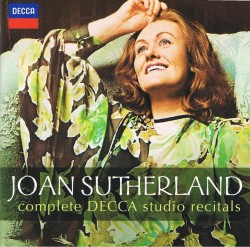 JOAN SUTHERLAND - The complete Decca Studio Recordings (DECCA 4783243, 23CDs, Limited Edition). The late Joan Sutherland (1926-2010) was one of the outstanding sopranos of the last century and she was known to the millions who were never privileged to hear her live through her many Decca recordings of operas and recitals. She was a commanding figure in person but it was her voice alone that won her a devoted following. To honour her, Decca has assembled every one of her studio recitals and packaged them in this attractive set. Her husband Richard Bonynge was, progressively, her pianist, coach and conductor. They married in 1954 and he directed her towards the baroque repertoire, the bel canto period and French works of the 19th century. The turning point in her career came on the evening of February 17, 1959, when she sang the title role in the first production at Covent Garden in 35 years of Lucia de Lammermoor. The performance was a well-deserved triumph for Sutherland and immediately her name was recognized in operatic circles around the world. She retired from the stage in 1990. Included in the 23 CDs are Art of the Prima Donna, Command Performance, Age of Bel Canto, The Noel Coward Album, Songs My Mother Taught Me, The Mozart Album and many more. The albums date from 1959, Operatic Arias through to 1986, Talking Pictures – Songs from the Movies and finally from 1987, Romantic Trios for soprano, horn and piano, with Barry Tuckwell and Bonynge (all born in Sydney – a nice ending to her recording career). The enclosed booklet contains full recording details and a short biography. In 1995 she acted in an Australian movie with Leo McKern and Geoffrey Rush entitled Dad and Dave on our selection. Sutherland plays Mum (a non-singing role) with no makeup or made-up to appear not to be wearing any. Set in rural Queensland, the characters are familiar to Australians. It’s a very dreary film.
JOAN SUTHERLAND - The complete Decca Studio Recordings (DECCA 4783243, 23CDs, Limited Edition). The late Joan Sutherland (1926-2010) was one of the outstanding sopranos of the last century and she was known to the millions who were never privileged to hear her live through her many Decca recordings of operas and recitals. She was a commanding figure in person but it was her voice alone that won her a devoted following. To honour her, Decca has assembled every one of her studio recitals and packaged them in this attractive set. Her husband Richard Bonynge was, progressively, her pianist, coach and conductor. They married in 1954 and he directed her towards the baroque repertoire, the bel canto period and French works of the 19th century. The turning point in her career came on the evening of February 17, 1959, when she sang the title role in the first production at Covent Garden in 35 years of Lucia de Lammermoor. The performance was a well-deserved triumph for Sutherland and immediately her name was recognized in operatic circles around the world. She retired from the stage in 1990. Included in the 23 CDs are Art of the Prima Donna, Command Performance, Age of Bel Canto, The Noel Coward Album, Songs My Mother Taught Me, The Mozart Album and many more. The albums date from 1959, Operatic Arias through to 1986, Talking Pictures – Songs from the Movies and finally from 1987, Romantic Trios for soprano, horn and piano, with Barry Tuckwell and Bonynge (all born in Sydney – a nice ending to her recording career). The enclosed booklet contains full recording details and a short biography. In 1995 she acted in an Australian movie with Leo McKern and Geoffrey Rush entitled Dad and Dave on our selection. Sutherland plays Mum (a non-singing role) with no makeup or made-up to appear not to be wearing any. Set in rural Queensland, the characters are familiar to Australians. It’s a very dreary film.
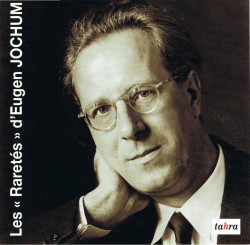 Eugen Jochum: Rare Recordings (TAHRA 720) It was with singular pleasure that I listened to the second suite from Daphnis et Chloé played by the Bavarian Rundfunks Orchestra on this new release from Tahra. Jochum founded the orchestra in 1949 at the bidding of Bavarian Radio, creating one of Europe’s very finest ensembles. The often played Ravel suite is an excellent example of the composer’s meticulous craftsmanship and this virtuoso performance from October 1950 is played with an unexpected subtlety of timbre worthy of the finest French interpretation. Annelies Kupper was a German operatic soprano, well known and admired in her day as an interpreter of Mozart, Wagner and Richard Strauss. Her repertoire on CD is quite extensive but here, from December 1950 is her only recording of The Four Last Songs, richly sung with assurance and ardor and sumptuously supported by Jochum. The overture to Die Fledermaus is played with a sparkling exuberance that is usually heard only from the pit. The overture to Handel’s Agrippina is followed by Mozart’s Rondo K382 for piano and orchestra played with Edwin Fischer at the 1954 Wurzburg Festival. There are no complaints about the sound which is full-bodied, often with a natural, front to back dimension and with virtually no recording artifacts. This is the latest release from Tahra devoted to performances conducted by Jochum and all the works are new to his recorded repertoire.
Eugen Jochum: Rare Recordings (TAHRA 720) It was with singular pleasure that I listened to the second suite from Daphnis et Chloé played by the Bavarian Rundfunks Orchestra on this new release from Tahra. Jochum founded the orchestra in 1949 at the bidding of Bavarian Radio, creating one of Europe’s very finest ensembles. The often played Ravel suite is an excellent example of the composer’s meticulous craftsmanship and this virtuoso performance from October 1950 is played with an unexpected subtlety of timbre worthy of the finest French interpretation. Annelies Kupper was a German operatic soprano, well known and admired in her day as an interpreter of Mozart, Wagner and Richard Strauss. Her repertoire on CD is quite extensive but here, from December 1950 is her only recording of The Four Last Songs, richly sung with assurance and ardor and sumptuously supported by Jochum. The overture to Die Fledermaus is played with a sparkling exuberance that is usually heard only from the pit. The overture to Handel’s Agrippina is followed by Mozart’s Rondo K382 for piano and orchestra played with Edwin Fischer at the 1954 Wurzburg Festival. There are no complaints about the sound which is full-bodied, often with a natural, front to back dimension and with virtually no recording artifacts. This is the latest release from Tahra devoted to performances conducted by Jochum and all the works are new to his recorded repertoire.
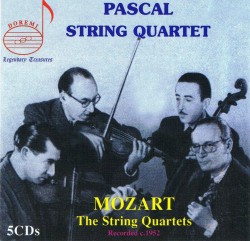 Some years ago in Dallas we interviewed Andrew Litton who was then music director of the Dallas Symphony. He stated that very soon all symphony orchestras will sound the same. Well, it is very close to being true now as orchestral musicians move from orchestra to orchestra and from country to country, as do conductors. But there can be no denying that there was a unique sound to the French School of string quartet playing, such as the Calvet, Loewenguth, Parrinen, Krettley and Pascal quartets. All were characterized by their elegance and purity of style, immaculate intonation and humility in the face of the music. DOREMI has issued 22 Mozart String Quartets performed by the Pascal Quartet, circa 1952 (DOREMI DHR-8001-5, 5CDs). Mozart string quartets, particularly the ten mature ones, are arguably among the finest gems in classical music. In listening to the Pascals playing one senses that they are playing for the love of the music and that the microphone just happens to be listening in. The juvenile quartets are played with the same respect and appreciation. The original recorded sound was ideal in every respect and the meticulous transfers from the Musical Masterpiece Society LPs restore these radiant performances to life. This set is essential Mozart.
Some years ago in Dallas we interviewed Andrew Litton who was then music director of the Dallas Symphony. He stated that very soon all symphony orchestras will sound the same. Well, it is very close to being true now as orchestral musicians move from orchestra to orchestra and from country to country, as do conductors. But there can be no denying that there was a unique sound to the French School of string quartet playing, such as the Calvet, Loewenguth, Parrinen, Krettley and Pascal quartets. All were characterized by their elegance and purity of style, immaculate intonation and humility in the face of the music. DOREMI has issued 22 Mozart String Quartets performed by the Pascal Quartet, circa 1952 (DOREMI DHR-8001-5, 5CDs). Mozart string quartets, particularly the ten mature ones, are arguably among the finest gems in classical music. In listening to the Pascals playing one senses that they are playing for the love of the music and that the microphone just happens to be listening in. The juvenile quartets are played with the same respect and appreciation. The original recorded sound was ideal in every respect and the meticulous transfers from the Musical Masterpiece Society LPs restore these radiant performances to life. This set is essential Mozart.



